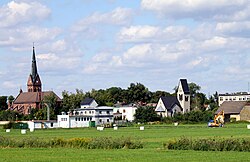Gogolin
Gogolin | |
|---|---|
 | |
 Flag  Coat of arms | |
 Gogolin | |
| Coordinates: 50°29′17″N 18°1′26″E / 50.48806°N 18.02389°ECoordinates: 50°29′17″N 18°1′26″E / 50.48806°N 18.02389°E | |
| Country | |
| Voivodeship | Opole |
| County | Krapkowice |
| Gmina | Gogolin |
| First mentioned | 1223 |
| Town rights | 1967 |
| Area | |
| • Total | 20.35 km2 (7.86 sq mi) |
| Population (2019-06-30[1]) | |
| • Total | 6,682 |
| • Density | 330/km2 (850/sq mi) |
| Time zone | UTC+1 (CET) |
| • Summer (DST) | UTC+2 (CEST) |
| Postal code | 47-320 |
| Website | http://gogolin.pl |
Gogolin [ɡɔˈɡɔlʲin] is a town in Poland, in Opole Voivodeship, in Krapkowice County. It has 6,682 inhabitants (2019).
From 1742 to 1945 the town was part of Austrian, Prussian, and then German Silesia. It is known by the same name in German and is one of the few places in Poland whose name has never been Germanized. A German-speaking minority remains.
Geology and palaeontology[]
Gogolin gives its name to the Gogolin Formation whose strata were first exposed here.
History[]
The oldest known mention of Gogolin, under its Old Polish name Gogolino, comes from a 1223 document of Wawrzyniec, bishop of Wrocław.[2]
Formerly part of Austrian Silesia, Gogolin was within the Prussian Province of Silesia from 1815 until 1919, and then the Province of Upper Silesia until 1945.[2]
In the 19th century, the Prussian exploitation of local limestone deposits began on an industrial scale, and the first lime kilns were built.[2] Also a train station was built, and Gogolin enjoyed railway connections with Oppeln, Kandrzin-Cosel, and Prudnik.[2] Heavy fights of the Silesian Uprisings took place nearby in 1921.[2] At the Upper Silesia plebiscite of 20 March 1921, there were 1,262 votes for remaining in Germany and 955 for being transferred to Poland.[3] In the event, the town remained in the Weimar Republic. During World War II the Germans established a forced labour camp for Poles and Jews[4] and two labour camps (E131 and E132) of the Stalag VIII-B/344 prisoner-of-war camp at Łambinowice.[5] About 30 buildings were destroyed in the final stages of the war in 1945.[2]
The Potsdam Conference of 1945 defined the Oder-Neisse line as the border between Germany and Poland, pending a peace conference with Germany which never took place.[6] Between 1945 and 1946, nearly all of the 4.5 million German-speaking Silesians fled or were forcibly expelled. Many migrants arrived from Central Poland, some forcibly re-settled from the areas of Poland annexed by the Soviet Union.[7]
A high school was established in 1948, and in 1967 Gogolin was granted town rights.[2]
The town is known for its old regional folk song Poszła Karolinka do Gogolina,[8] which is a symbol regional Polish traditions.[9] The song's characters of Karolinka and Karlik are depicted in the town's coat of arms, along with a lime kiln, alluding to the town's traditions.[9] There is also a monument of Karolinka and Karlik in the town centre.
Population[]
Population in 1782–2005.[10]
|
|
Twin towns – sister cities[]
See twin towns of Gmina Gogolin.
Gallery[]

Town center at night with the culture centre on the left
Mass grave of Polish insurgents of 1921
Old lime kilns

Post office
References[]
- ^ "Population. Size and structure and vital statistics in Poland by territorial division in 2019. As of 30th June". stat.gov.pl. Statistics Poland. 2019-10-15. Retrieved 2020-02-14.
- ^ Jump up to: a b c d e f g "Atrakcje turystyczne". Urząd Miejski w Gogolinie (in Polish). Retrieved 14 March 2020.
- ^ Results of the Upper Silesia plebiscite, archive.org, accessed 19 July 2021
- ^ "Obóz pracy - Zwangsarbeitslager Gogolin". Wirtualny Sztetl (in Polish). Retrieved 14 March 2020.
- ^ "Working Parties". Stalag VIIIB 344 Lamsdorf. Retrieved 14 March 2020.
- ^ Geoffrey K. Roberts, Patricia Hogwood (2013). The Politics Today Companion to West European Politics. Oxford University Press. p. 50. ISBN 9781847790323.; Piotr Stefan Wandycz (1980). The United States and Poland. Harvard University Press. p. 303. ISBN 9780674926851.; Phillip A. Bühler (1990). The Oder-Neisse Line: a reappraisal under internaromtional law. East European Monographs. p. 33. ISBN 9780880331746.
- ^ Lukowski, Zawadski, Jerzy, Hubert (2006). A Concise History of Poland. Cambridge, UK: Cambridge University Press. pp. 278–280. ISBN 978-0-521-61857-1.
- ^ "Poszła Karolinka do Gogolina". Urząd Miejski w Gogolinie (in Polish). Retrieved 14 March 2020.
- ^ Jump up to: a b "Herb i flaga miasta Gogolin". Urząd Miejski w Gogolinie (in Polish). Retrieved 14 March 2020.
- ^ Population figures: 1784: [1] – 1830: [2] – 1844: [3] – 1855, 1861: [4] – 1885: [5] - 1900: [6] - 1910: [7] – 1933, 1939: [8] – 1995, 2000, 2005: [9]
External links[]
- Official town webpage
- Jewish Community in Gogolin on Virtual Shtetl
- Cities in Silesia
- Cities and towns in Opole Voivodeship
- Krapkowice County







